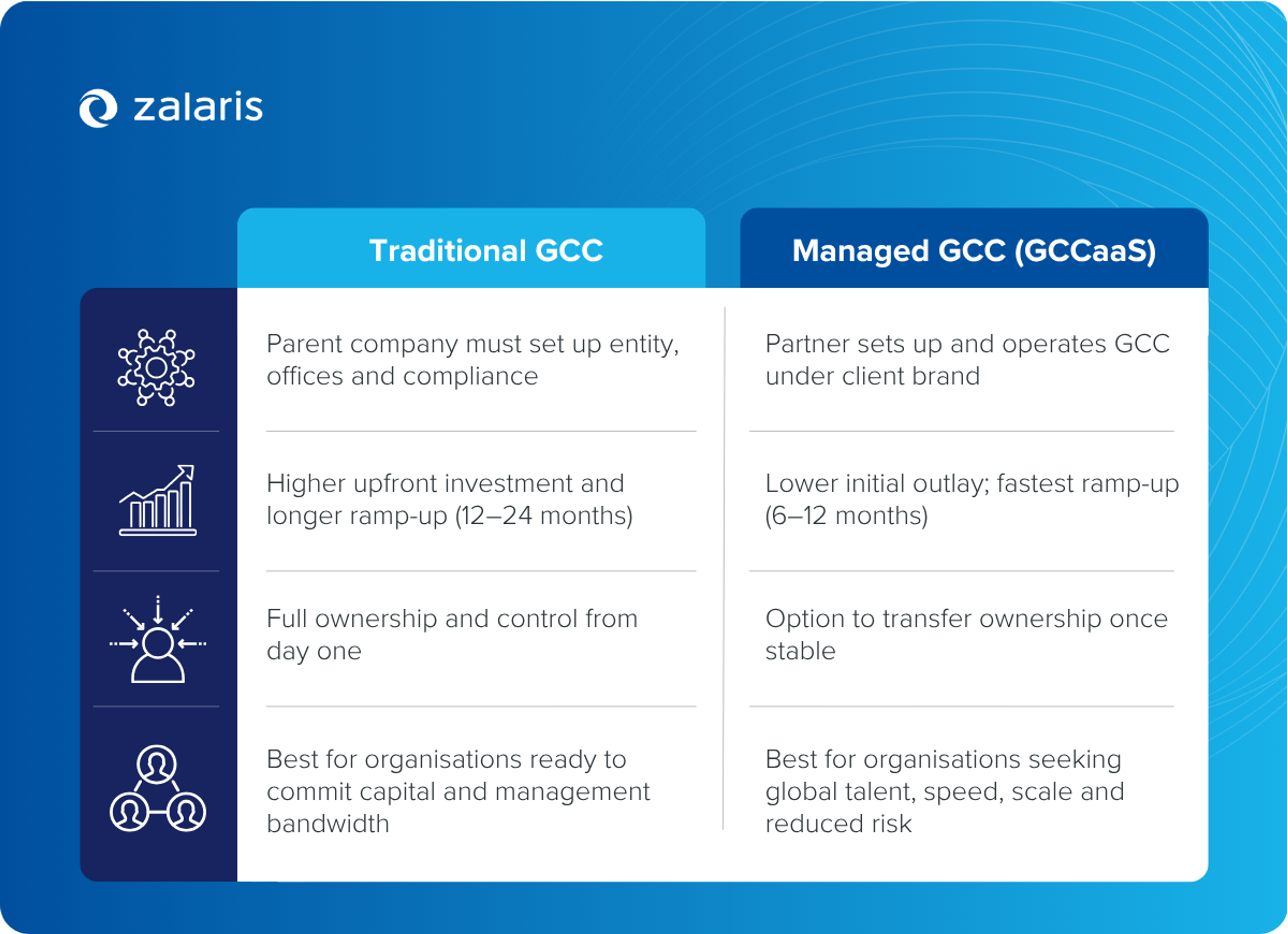From Outsourcing to GCCaaS: The next evolution in Global Capability Centres
Traditional outsourcing and captive centres no longer provide the agility or ownership that modern business demands. Managed Global Capability Centers (GCCs), or GCC-as-a-Service, offer a more flexible model that reduces complexity, accelerates set-up and creates a foundation for long-term strategic value.
Balakrishnan Narayanan

What is a Global Capability Center (GCCs)?
A Global Capability Centre (GCCs) is much more than a traditional offshore backoffice. Owned and operated by the parent company, a GCC acts as an extension of headquarters, delivering multifunction services such as engineering, finance, analytics, R&D and HR. While early outsourcing models focussed on cost-savings and labour arbitrage, modern global capability centers have evolved into strategic innovation hubs that mirror the parent firm’s operations and leadership structure.
With digital transformation accelerating and competition for skilled professionals intensifying, organisations are turning to GCCs to balance cost, speed, innovation and resilience. India alone hosts roughly 1,700 GCCs employing 1.9 million people and generating US $64.6 billion in export revenue in FY 2024. Everest group projects the market could expand to US $99–105 billion by 2030. The growing popularity of GCCs marks a shift towards creating strategic centres that support innovation, growth and global reach.
Why Managed GCCs (GCCaaS) are gaining popularity
Traditional GCCs require large investments of both time and capital to stand up. Managed GCCs, also known as GCC-as-a-Service, shift the heavy lift to a specialist partner while the centre runs under the purview of the parent company. Instead of incorporating a new entity, leasing space and building local leadership from scratch, enterprises can partner with specialists who establish and operate the GCC under the client’s brand.
The appeal is clear. Everest Group notes providers now support the full GCC life cycle, not only the initial launch, which is why these models are scaling quickly. GCCaaS is usually delivered through two major models: the Build-Operate-Transfer (BOT) model and the Build-Operate-Own-Transfer (BOOT) model.
Build-Operate-Transfer (BOT) means a partner builds the GCC, operates it for a defined period, then transfers it to the enterprise. Build-Operate-Own-Transfer (BOOT) is similar, except the partner also owns the asset during the operation phase, then hands it over once the centre stabilises. In India, BOT and related assisted models have moved from a niche to a mainstream choice, with Everest Group reporting that BOT-style setups have risen from under 10 percent a few years ago to about 40% of new GCCs.
Balakrishnan Narayanan, EVP APAC and CSO shares insights into Managed GCCs
Traditional outsourcing and alternative models: How are Managed GCCs different?
Global enterprises have long relied on different models to scale operations - from outsourcing to captive centres and, more recently, GCCs. Each of these approaches offers a balance of cost, control and speed, but each also comes with trade-offs that limit its ability to meet today’s demands for agility and innovation.
Managed GCCs, or GCCaaS, are emerging as the next step because they combine the operational excellence of a GCC with faster ramp-up and reduced overhead.
The table below provides a comparative view of the key differences across ownership, investment, time-to-value and innovation potential of outsourcing, captive centres (GICs) and GCCs.
Comparative overview: Outsourcing vs. Captive centres vs. GCCs vs. GCCaaS
| Model | Ownership & control | Time to establish | Investment profile | Best suited for | Innovation potential |
|---|---|---|---|---|---|
| Outsourcing | Vendor-owned; delivery remains with provider | Very fast (weeks) | Low upfront; fees based on contract/service | Transactional or commoditised processes | Low -efficiency-driven |
| Captive centre (GIC) | Fully parent-owned and managed | Slow (18–36 months) | High upfront (entity, premises, compliance, leadership) | Sensitive processes where control is essential | Limited - often back-office focused |
| Traditional GCC | Parent-owned; integrated into enterprise model | Medium (12–24 months) | Significant setup effort, but scales more flexibly once built | Multi-function hubs (engineering, data analytics, HR, finance, software development) | High - operate as extensions of HQ |
| Managed GCC (GCCaaS) | Built and run by partner under client brand; option to transfer ownership | Fastest (6–12 months) | Lower upfront; managed service fee model; transfer cost if applicable | Strategic functions needing speed, scale and resilience | High -combines the advantages of GCCs with shorter time-to-standup and lower capital costs. |
Outsourcing delivers cost efficiency, but its role is shifting
Conventional outsourcing still adds capacity fast for well-defined services like payroll processing, service desks, or application maintenance. While it’s faster to outsource processes, many organisations do not simply want to reduce costs – they want to retain control and ownership, regardless of geographical location.
Deloitte’s 2024 outsourcing survey found that 80% of executives plan to maintain or increase third-party outsourcing, but priorities increasingly include agility, access to scarce skills, and outcome-based delivery - not just cost savings.
How this differs from GCCaaS
- Ownership and IP: Outsourcing hands over core capabilities to a vendor, while GCCaaS builds a global capability center inside the client’s structure and brand, creating an asset that can be shifted in-house at transfer.
- Cultural alignment and knowledge: Outsourcing keeps teams outside the enterprise fabric, while GCCaaS embeds specialised knowledge and global talent that remain after transfer.
- Strategic runway: Outsourcing is strongest for transactional scope, while GCCaaS is designed to evolve into a multi-function hub that can drive innovation and operational excellence as it matures.
Captive centres handle back-office operations, but need large investments
Captive centres, also known as Global In-House Centres, were the go-to model for multinational organisations wanting to scale in the 1990s and 2000s. Companies established wholly owned entities in offshore hubs to capture labour arbitrage and protect sensitive processes.
The model delivered ownership and compliance, but required time and capital to incorporate entities, secure facilities, and build local leadership. Many captives matured into efficient back offices rather than engines of product or platform innovation.
How this differs from GCCaaS
- Speed to value: Captives take longer because the enterprise must establish everything itself. GCCaaS uses a specialist partner to set up and run the centre under the client brand, compressing time to steady state.
- Investment model: Captives demand upfront capital expenditure and permanent overhead. GCCaaS starts as a managed service with lower initial investment and a path to transfer when ready.
- Operating risk: Captives involve regulatory, real-estate and recruitment risks for enterprises. GCCaaS shares early-stage risk with the partner during both the build phase and the operation phase.
Modern GCCs are strategic hubs
As digital programmes scaled, many firms shifted from back-office captives to modern Global Capability Centers that mirror headquarters and run engineering, data analytics, finance and CX work.
GCCs are often established in countries like India and the Philippines that host highly skilled talent at lower costs. For European organisations under strict GDPR regulations, near-shore locations like Poland and Latvia are attractive options. However, setting up an independent GCC without a local partner can be a challenge.
How this differs from GCCaaS
- Set-up friction: A traditional GCC requires the enterprise to handle incorporation, facilities and compliance directly. GCCaaS delegates these responsibilities to the partner while running global operations under the client brand.
- Operator model: GCCs are owned and managed by the enterprise from day one. GCCaaS delivers the same strategic remit with a staged path to full ownership.
- Adoption curve: GCCs are more prevalent in multinational organisations with an existing presence in their chosen location, while assisted and BOT-style models are preferred by organisations expanding to new geographies.

Challenges and considerations with Managed GCCs
Even when organisations choose the Managed GCC route, there are important considerations that shape success:
- Defining the transfer path: BOT and BOOT models are attractive because they offer speed with a route to ownership, but the timeline and criteria for transfer must be clear from the start. Without agreed milestones, handovers can stall.
- Partner governance: A GCCaaS provider plays a central role in early years. Strong governance frameworks covering service levels, IP ownership, and escalation paths protect the enterprise’s interests and build trust.
- Talent integration: While partners recruit and manage local teams, employees still need to feel part of the parent company. Regular leadership touchpoints and cultural onboarding help the global capability center align with strategic objectives.
- Scaling scope: Many Managed GCCs begin with a single function, such as payroll or data analytics. Designing for multi-function expansion early avoids rework and accelerates growth into a centre of global operations.
- Location and resilience: India remains the epicentre, but demand is spreading to Tier-2 cities and alternative hubs. Working with partners that can flex across geographies ensures risk management against local disruptions.
Why Zalaris is the right partner for GCC-as-a-Service
As organisations face rising costs, talent shortages and compliance demands across multiple jurisdictions, the managed GCC model has become a strategic evolution in service delivery. It gives enterprises the cost benefits of offshore operations while retaining the strategic control that critical functions like HR and payroll require.
Zalaris’ Managed GCC service builds on two decades of experience in multi-country HR and payroll. The model is designed on a structured Build–Operate–Optimise approach, which means capacity can be stood up in weeks, with operational efficiency, governance, compliance and quality embedded from day one. Customers benefit from:
- Rapid scale-up with a proven track record of expanding strategically and sustainably across geographies
- Compliance-by-design controls aligned to both local laws and international standards
- Cost-to-serve reductions while maintaining accuracy and timeliness at benchmark levels
- Flexible engagement models, including Build–Operate–Optimise and Build–Own–Operate–Transfer, giving enterprises options on long-term ownership
By combining global talent pools in India and the Philippines with Zalaris’ established nearshore hubs in Poland, Latvia and Spain, clients gain a resilient, compliant operating model that meets GDPR regulatory requirements and integrates seamlessly with existing HR and payroll landscapes.
Visit our website to learn more, or get in touch with our experts today.
Frequently Asked Questions (FAQ):
1. How do Global Capability Centers (GCCs) support business growth?
GCCs extend an organisation’s reach into global talent pools and provide scale across functions such as engineering, analytics, HR and finance. By integrating closely with headquarters, they reduce costs, accelerate digital transformation, deliver operational excellence and create hubs for innovation. This combination of efficiency and capability makes them powerful enablers of business growth in competitive markets.
2. Is a Managed GCC the same as outsourcing?
No. Outsourcing hands delivery over to a vendor, while a Managed Global Capability Center is built and run under the client’s brand. Intellectual property, knowledge and culture stay inside the enterprise, and there is usually a path to transfer ownership once the GCC stabilises.
3. How fast can a Managed GCC be set up?
With a service partner handling incorporation, facilities and recruitment, a Managed GCC can typically reach steady state within 6–12 months, often more than a year faster than a traditional build. Zalaris’ structured Build-Operate-Optimise model allows initial capacity global capability centers to go live in just weeks.
4. What types of functions work best in a Managed GCC?
The model works well for HR and payroll, analytics, finance and other global operations. It is particularly effective where compliance, process standardisation and talent depth are critical and highly skilled global talent is needed for smooth execution.
5. What happens when the enterprise wants to take ownership?
Build-Operate-Transfer (BOT) and Build-Operate-Own-Transfer (BOOT) models give organisations the option to assume control when ready. Transfer timelines and milestones are agreed at the outset, ensuring a smooth handover of teams, infrastructure management, processes and governance.
6. Is GCCaaS only relevant for GCCs in India?
No. India is the largest hub, but Managed GCCs are also growing in the Philippines, Poland, Latvia and Spain. Zalaris is a service provider who supports clients with both offshore and nearshore options to balance scale, cost and resilience.
Related content

Balakrishnan Narayanan
Executive Vice President APAC & Chief Sustainability Officer
Balakrishnan Narayanan is Executive Vice President of APAC. He has led Zalaris’ offshore center in India since inception in 2015 and has been instrumental in the growth and expansion of Zalaris India as well as the company across all its operations.
Table of Contents
- What is a Global Capability Center (GCCs)?
- Why Managed GCCs (GCCaaS) are gaining popularity
- Traditional outsourcing and alternative models: How are Managed GCCs different?
- Outsourcing delivers cost efficiency, but its role is shifting
- How this differs from GCCaaS
- Captive centres handle back-office operations, but need large investments
- How this differs from GCCaaS
- Modern GCCs are strategic hubs
- How this differs from GCCaaS
- Challenges and considerations with Managed GCCs
- Why Zalaris is the right partner for GCC-as-a-Service
- Frequently Asked Questions (FAQ):

